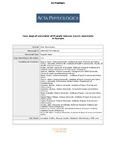Four days of simulated shift work reduces insulin sensitivity in humans

Date
2018-06Author
Subject
Metadata
Show full item recordAbstract
<jats:title>Abstract</jats:title><jats:sec><jats:title>Aim</jats:title><jats:p>The aim of this study was to investigate the effects of 4 consecutive simulated night shifts on glucose homeostasis, mitochondrial function and central and peripheral rhythmicities compared with a simulated day shift schedule.</jats:p></jats:sec><jats:sec><jats:title>Methods</jats:title><jats:p>Seventeen healthy adults (8M:9F) matched for sleep, physical activity and dietary/fat intake participated in this study (night shift work n<jats:italic> </jats:italic>=<jats:italic> </jats:italic>9; day shift work n<jats:italic> </jats:italic>=<jats:italic> </jats:italic>8). Glucose tolerance and insulin sensitivity before and after 4 nights of shift work were measured by an intravenous glucose tolerance test and a hyperinsulinaemic euglycaemic clamp respectively. Muscles biopsies were obtained to determine insulin signalling and mitochondrial function. Central and peripheral rhythmicities were assessed by measuring salivary melatonin and expression of circadian genes from hair samples respectively.</jats:p></jats:sec><jats:sec><jats:title>Results</jats:title><jats:p>Fasting plasma glucose increased (4.4 ± 0.1 vs. 4.6 ± 0.1 mmol L<jats:sup>−1</jats:sup>; <jats:italic>P</jats:italic> = .001) and insulin sensitivity decreased (25 ± 7%, <jats:italic>P</jats:italic> < .05) following the night shift, with no changes following the day shift. Night shift work had no effect on skeletal muscle protein expression (<jats:styled-content style="fixed-case">PGC</jats:styled-content>1α, <jats:styled-content style="fixed-case">UCP</jats:styled-content>3, <jats:styled-content style="fixed-case">TFAM</jats:styled-content> and mitochondria Complex <jats:styled-content style="fixed-case">II</jats:styled-content>‐V) or insulin‐stimulated <jats:styled-content style="fixed-case">pA</jats:styled-content>kt Ser473, <jats:styled-content style="fixed-case">pTBC</jats:styled-content>1D4Ser318 and <jats:styled-content style="fixed-case">pTBC</jats:styled-content>1D4Thr642. Importantly, the metabolic changes after simulated night shifts occurred despite no changes in the timing of melatonin rhythmicity or hair follicle cell clock gene expression across the wake period (<jats:italic>Per3</jats:italic>,<jats:italic> Per1</jats:italic>,<jats:italic> Nr1d1</jats:italic> and <jats:italic>Nr1d2</jats:italic>).</jats:p></jats:sec><jats:sec><jats:title>Conclusion</jats:title><jats:p>Only 4 days of simulated night shift work in healthy adults is sufficient to reduce insulin sensitivity which would be expected to increase the risk of T2D.</jats:p></jats:sec>
Collections
Publisher
Place of Publication
Journal
Volume
Issue
Pagination
Number
Recommended, similar items
The following license files are associated with this item:

